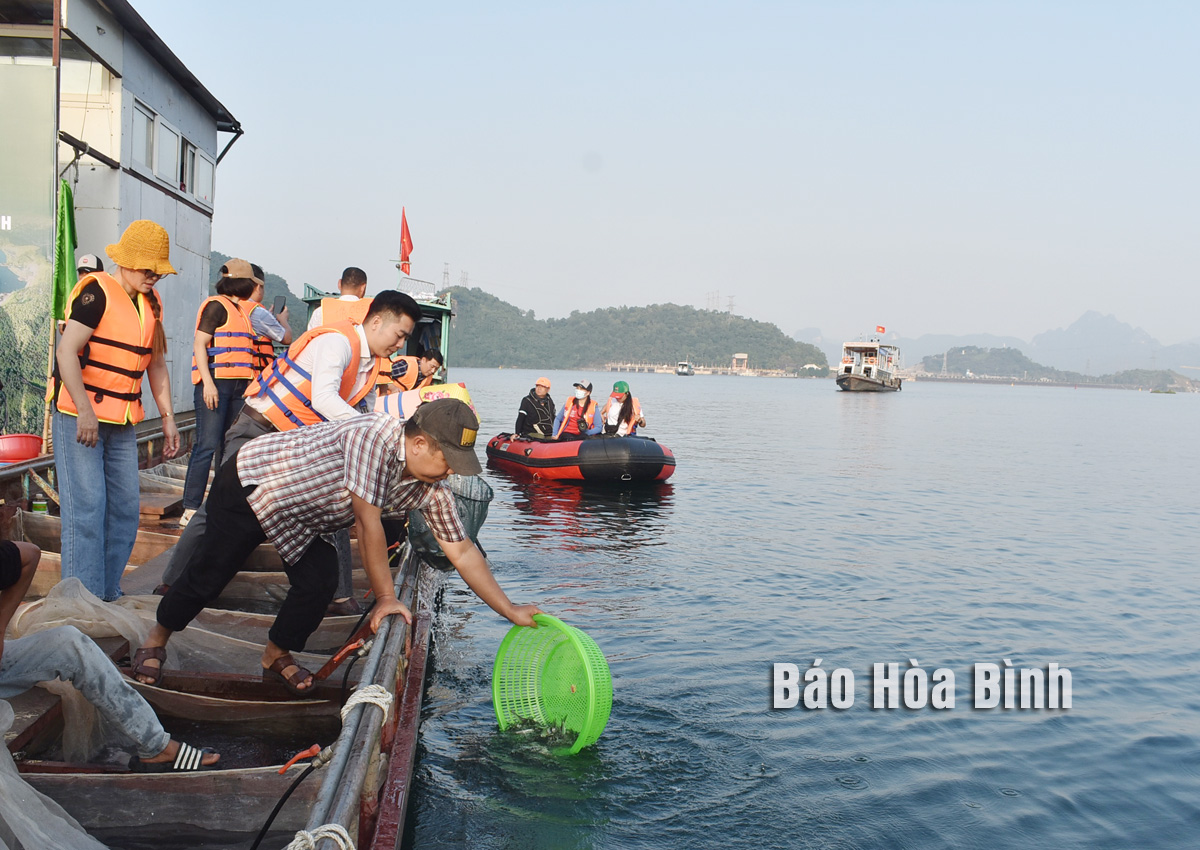
After the construction of the Da River dam, Hoa Binh Reservoir became the largest artificial lake in Vietnam, stretching 230km from Hoa Binh province to Son La province.
Located within Hoa Binh province, the reservoir spans the administrative boundaries of Hoa Binh city and four districts: Da Bac, Cao Phong, Tan Lac, and Mai Chau.
Annually, the
Fisheries Sub-Department (under the Department of Agriculture and Environment)
collaborates with various agencies and enterprises to release tonnes of fish
fry into Hoa Binh Reservoir to regenerate aquatic resources.
With its vast surface area and a capacity of over 9 billion cubic
metres, Hoa Binh Reservoir is considered a valuable treasure trove of aquatic
life and fisheries resources. According to research, the reservoir is home to
123 species from 79 genera and 19 families, including many rare, economically
valuable species with scientific research significance. The diverse and
abundant aquatic resources have provided a long-term livelihood for the local
residents around the reservoir. However, in recent years, destructive fishing methods,
such as the use of explosives and electricity, have posed serious risks to the
reservoir’s ecosystem.
Nguyen Huy Nhuan, Director of the Department of
Agriculture and Environment said to effectively harness the potential of the
area and sustainably manage and protect fisheries resources, the agricultural
sector has advised the provincial Party Committee and People’s Committee to
issue directives and policies on fish farming in the Da River Reservoir and
other large reservoirs.
The provincial administration has paid special
attention to planning, developing policies to encourage fisheries, and
protecting and regenerating aquatic resources while maintaining ecosystem
balance and providing livelihoods for local communities. Additionally, local
authorities are tasked with preventing illegal fishing methods, ensuring a
healthy environment for aquatic species. To replenish fish stocks, the province
annually allocates budget and encourages businesses to release large quantities
of fish fry into the natural environment.
According to Executive Director of Hai Dang
Group Fisheries Co., Ltd. Nguyen Thi Dung, in addition to producing,
processing, cultivating, and trading fish products, the company annually
allocates funds for releasing different fish species to diversify and
regenerate aquatic resources in the reservoir area.
Alongside efforts to restock aquatic resources,
environmental protection has been a key focus. Relevant authorities and
localities have ramped up awareness campaigns to educate people on the
importance of protecting fisheries resources and the habitats of aquatic
species, both in the wild and in aquaculture. Local residents are encouraged to
comply with legal regulations, avoid using electric shocks, toxins, or
explosives in fishing, and only fish during authorised seasons and within the
legal size limits. Routine patrols and inspections are conducted to promptly
detect and address violations, while raising public awareness of legal
requirements for aquaculture.
Nguyen Van Chieu, Deputy Chairman of the Hoa
Binh commune People's Committee, Hoa Binh city, noted that the commune has two
villages along the reservoir. Local police and military forces have worked to
inform and persuade the public to avoid prohibited substances and harmful
fishing equipment, helping people understand that protecting fisheries
resources in the reservoir area is essential for preserving their own
livelihoods.
In protecting fisheries, local authorities
strengthen checks and punishments for violations such as using explosives,
electricity, or toxins for fishing. They promptly confiscate illegal equipment
and work to conserve and protect aquatic ecosystems and endangered, rare
species. Training sessions and campaigns on the Fisheries Law and related
regulations are regularly organised, guiding residents on how to avoid
introducing invasive aquatic species that could harm the environment, thus
fostering greater public awareness of efforts to protect, regenerate, and
develop fisheries resources.
According to data from the Hoa Binh Provincial Party Committee, the industrial production index for the first six months of 2025 is estimated to have increased by 20% compared to the same period last year. This marks the highest year-on-year growth rate for this period since 2020.
In the first six months of 2025, Hoa Binh province’s export turnover was estimated at 1.145 billion USD, marking an 18.11% increase compared to the same period in 2024. Import turnover was estimated at $ 804 million, a 17.15% increase, which helped the province maintain a positive trade balance.
The lives of the ethnic minority farmers in Tan Lac district have gradually improved thanks to the new directions in agricultural production. This is a testament to the collective strength fostered through the professional associations and groups implemented by various levels of the district’s Farmers’ Union.
With the motto the "product quality comes first,” after nearly one year of establishment and operation, Muong village’s Clean Food Agricultural and Commercial Cooperative, located in Cau Hamlet, Hung Son Commune (Kim Boi district), has launched reputable, high-quality agricultural products to the market that are well-received by consumers. The products such as Muong village’s pork sausage, salt-cured chicken, and salt-cured pork hocks have gradually carved out a place in the market and they are on the path to obtaining the OCOP certification.
In the past, the phrase "bumper harvest, rock-bottom prices" was a familiar refrain for Vietnamese farmers engaged in fragmented, small-scale agriculture. But today, a new spirit is emerging across rural areas of Hoa Binh province - one of collaboration, organisation, and collective economic models that provide a stable foundation for production.
Maintaining growing area codes and packing facility codes in accordance with regulations is a mandatory requirement for agricultural products to be eligible for export. Recently, the Department of Agriculture and Environment of Hoa Binh province has intensified technical supervision of designated farming areas and packing facilities to safeguard the "green passport" that enables its products to access international markets.



